Appearance and Design
The Samsung 245T takes the traditional approach when it comes to appearance. The frame is a glossy black plastic with a matte black stand. Some might go as far as calling the stand clunky looking -- it reminds us of the original Dell 2405FPW stand -- but it does everything that's required. The only truly noteworthy omission is that there is no cable management system at all, so the cables just hang loose off the back of the monitor -- nothing a few zip-ties won't fix, if that's a serious concern.
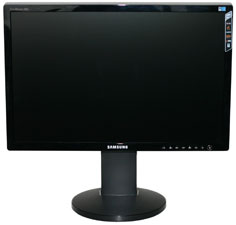 |
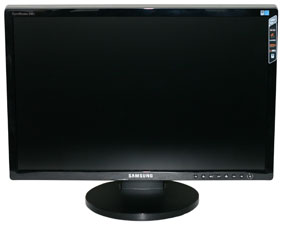 |
At the bottom right of the LCD, there are six buttons for accessing the on-screen display (OSD). Skipping the power button at the far right, which functions exactly as you would expect, the left button is a shortcut for enabling/disabling MPA. MPA stands for "Motion Picture Acceleration" and enabling it hopes to improve pixel response times. We'll find out later if it actually makes any noticeable difference in gaming as well. The second button brings up the main menu, and the next two buttons navigate through the menus. Pressing the menu button also exits out of submenus, while the fifth button (Source) acts as an enter button. When no other menus are active, the third button is a shortcut to cycle through the seven available color modes: Custom, Text, Internet, Game, Sports, Movie, and Dynamic CR. The fourth button also functions as a quick access to brightness levels, and the source button switches between available inputs -- note that if nothing is connected to an input, you can't switch to it without going through the full OSD menu. The Auto button is only useful in analog modes, where it will auto-adjust the screen size and centering, and the final PIP button turns on/off picture-in-picture.
 |
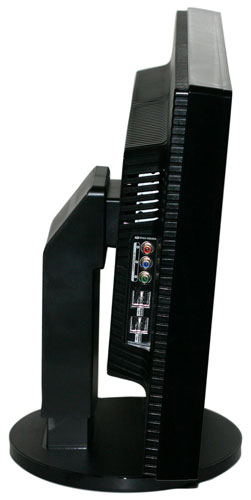 |
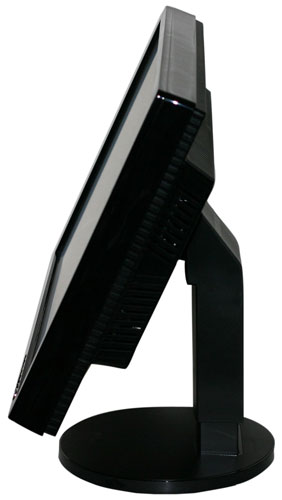 |
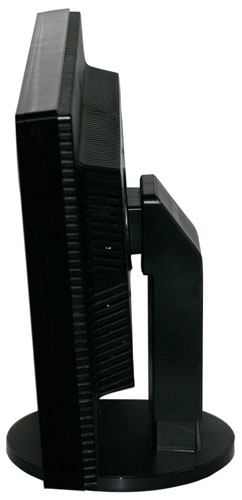 |
As mentioned earlier, the 245T supports the usual assortment of tilt, pivot, rotate, and height adjustment functions. You can see the range of motion available in the above images.
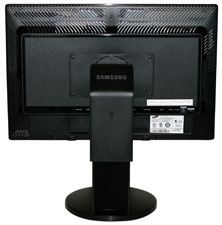 |
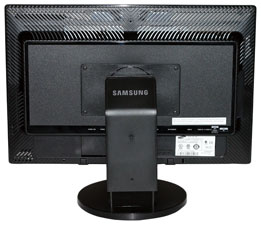 |
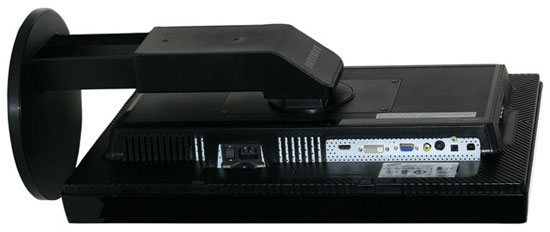 |
Most of the input ports all face downwards on the back of the display. The exception is the component input ports, which are on the left side of the display next to the four USB ports.
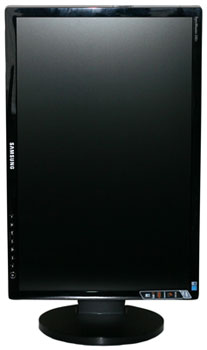 |
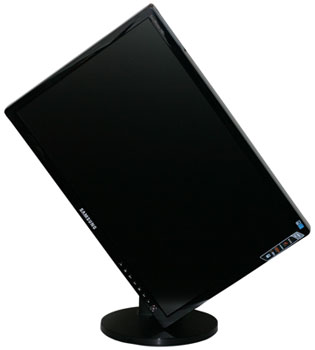 |
One nice feature of the stand is that it does allow you to raise the panel high enough that it can easily rotate into portrait mode. With some LCDs, we have found that you have to tilt the panel backwards as well as raising it to maximum height before you can rotate the display. If you find yourself frequently using portrait mode, the Samsung 245T would be a very good choice. Note also that the lack of cable management makes it easier to pivot the display.
We created a gallery showing all of the OSD menus and submenus, which you can access below. Most of the OSD functions are straightforward, but there are a few items worth pointing out.
First, there are multitudes of color adjustment options available. Not only can you adjust RGB levels, but you can also tweak hue and saturation via six color controls. We tend to find that amount of control more overwhelming than anything, but it's easy enough to ignore it and if you actually need such functionality it's there. Unfortunately, the second noteworthy item is a black mark; panel resolution scaling only offers two options: Wide or 4:3. "Wide" would be more appropriately named "stretch", as it will attempt to stretch any resolution to fill the entire screen -- without regards to aspect ratio. 4:3 on the other hand will fit any resolution into a 4:3 aspect ratio -- including 16:9 and 16:10 aspect ratios, even digital ones. What this all means is that sticklers who want 16:9 films not stretched vertically will be out of luck; similarly, people who connect an Xbox 360 or PS3 may be disappointed with the slightly stretched widescreen resolutions. What's missing from the scaling options are 1:1 (i.e. no stretch at all, giving black borders on all sides at lower resolutions) and proportional scaling (i.e. a 720p input would scale to fill 1920x1080, leaving black borders on the top and bottom edges) -- both of which are found on competing LCDs.
Update: The aspect ratio options are similar to what we found on the Samsung 2493HM when using the other input sources. In other words, 1:1 stretch is available on VGA connections. We no longer have the LCD, so we can't test the other inputs, but you can read the Samsung 2493HM review for more details.
















60 Comments
View All Comments
AnnonymousCoward - Monday, February 11, 2008 - link
Jarred, Jarred, Jarred...IMHO, this monitor is total garbage and unusable due to input lag. I don't think you should shrug it off since you can't detect it, as it is a big issue for many people.
Check out this great chart: http://www.tftcentral.co.uk/images/samsung_xl20/in...">http://www.tftcentral.co.uk/images/samsung_xl20/in...
You talked about measuring input lag...well, it's true that 2 DVI output ports could have a lag between the two, but we notice that they don't since the chart shows lags ranging from 1.6ms to 58.8ms (taken from average readings). That data validates user experiences, as well. Other sources have found that the 244T/245T have 55-65ms of input lag, and that the ports don't matter: http://tinyurl.com/2xl857">http://tinyurl.com/2xl857
Even if you can't perceive that, think about it in terms of ping. Is a 60ms ping the same as 120ms? This monitor effectively adds 60ms to your ping! And regardless of games, this isn't at all acceptable to me for a mouse cursor in Windows; the delayed feedback makes it harder to precisely point at anything.
Thanks anyway for the review, and normally I enjoy your writings.
JarredWalton - Monday, February 11, 2008 - link
Here's the problem with that chart of input lag:The GPU sends out a signal, at 60Hz. That means that the display gets a new image every 1/60s. So you can measure an input lag of 17ms, 33ms, 50ms, 67ms, 83ms, etc. What you can't measure are input lags of 2ms, 5ms, or any other value... unless the testing methodology itself is unsound.
They're taking an average, but an average of what? "We have 20 pictures that show no input lag and 20 pictures that show 1 frame of lag. That makes the average lag half a frame = 8.3ms." If the margin of error (due to output synchronization) is 1 frame - and it is in my testing - then lag is either undetectable, ~1 frame, ~2 frames, etc.
It could very well be that the 245T has worse lag than other displays. I don't have access to most of the displays they've tested, and I don't have any CRTs. I can compare results to a 2407WFP or 3007WFP, or maybe a couple other LCDs. However, the baseline would be inherently different.
I talked about the question http://www.anandtech.com/displays/showdoc.aspx?i=2...">here and later http://www.anandtech.com/displays/showdoc.aspx?i=2...">here, and at that point I decided that the methodology and reliability (with clearly different screen refreshes taking place in pictures) made the whole process virtually meaningless, so I stopped doing it.
If you want a figure of approximate lag, I can try to put a number of frames "lag" with a margin of error of 1. So anything less than one is apparently "equal" - which is what I found in every test I tried previously. To do an average is misleading - or at least an abstraction that hides the inherent flaws in the testing methodology - so I won't do that.
nevbie - Tuesday, February 12, 2008 - link
I don't know if this is reasonable - but if I were to think a way to measure input lag, it wouldn't be a comparison of clone moded monitors where other is a CRT and other is the subject.Instead I'd like to measure the time difference between pressing a button (mouse/keyboard) and a change that occurs on the screen. This is what people care about anyway. Of course such measurement would also count all the other delays caused by system, not just monitor only. (Now that sounds interesting, at least from a gamer standpoint!)
How to do it? I don't know. A combination of a device that sends a signal to the PC and "photographes" the LCD (or part of it) would do it (constantly photographes for some time, after input given to the PC). Software-wise, a program that keeps the screen black and waits for input, and turns it red if it gets the input would be enough. Perhaps a modded caliberator could be used (dunno about their functionality). With such system you could even measure lag caused by other hardware, let's say multi-GPU (if such lag exists, that is).
Just my thoughts..
AnnonymousCoward - Tuesday, February 12, 2008 - link
I agree with your theory, that input lag measurements should be in increments of 1/60s. For some reason, that's never how the measurements play out.I found just what you asked for: 70 data points from 7 monitors, graphed. http://tinyurl.com/2gajok">http://tinyurl.com/2gajok http://tinyurl.com/rgx9n">http://tinyurl.com/rgx9n
Looking at the data, I think it's reasonable to take the average of 10 readings, in spite of unknown measurement inaccuracies. Those averages give pretty good information about the real-world lag versus a CRT.
Here's an easy test you can do to expose the lag: move your mouse across the screen in an abrupt, sharp sweep. Compare when the sound of the mouse against the table ceases, versus when the cursor stops moving.
jimmy43 - Thursday, February 7, 2008 - link
I tend to agree on most points with you. However, input lag IS a real issue. For example, I use a monitor with 16ms refresh time and it doesnt bother me at all, while it would drive other people nuts. The same goes for input lag, and certain people's sensitivies.Incidentaly, the 244T had input lag so terrible I read countless reports of them being returned because they were completely unusable. This is from many different sources on many different sites. So the first thing I wanted to know about the 245T was weather or not it addressed this issue.
If you could, at the very least, just throw something about it in the subjective area then that would be helpful.
JarredWalton - Thursday, February 7, 2008 - link
Subjectively, I didn't notice anything related to lag compared to other LCDs. But if I'm not susceptible to that.... :)JarredWalton - Thursday, February 7, 2008 - link
And I added a note on the subjective evaluation for you.PPalmgren - Friday, February 8, 2008 - link
Input lag is the main thing I look for in LCD monitor reviews, and no one seems to want to cover it. It is the ultimate buying point for me. I "upgraded" from a Viewsonic VX922 to a NEC 2470WNX and the input lag made me put my 19 inch back of my desk. I mainly play RTSes and clicking accuracy is very important. When using the WNX I had major problems because of the delay, destroying my ability to click accurately on small things at high speed. In order to click dead-on, you have to guess your mouse distance exactly and click before the pointer shows up there on the screen. The input delay feels to be about 2-3 frames difference between my monitors. I currently have them both hooked up and use nView to switch between them now.Would it be possible to set a computer up for dualview and compare reviewed monitors side-by-side with a known well performer to measure input lag through a photo, etc? I think it would be a great thing for reviews. Since my purchase I've built 2 machines for customers who wanted 24'' monitors, and I've tested each of them with the same results (HP2408, Dell2407).
jimmy43 - Thursday, February 7, 2008 - link
I tend to agree on most points with you. However, input lag IS a real issue. For example, I use a monitor with 16ms refresh time and it doesnt bother me at all, while it would drive other people nuts. The same goes for input lag, and certain people's sensitivies.Incidentaly, the 244T had input lag so terrible I read countless reports of them being returned because they were completely unusable. This is from many different sources on many different sites. So the first thing I wanted to know about the 245T was weather or not it addressed this issue.
If you could, at the very least, just throw something about it in the subjective area then that would be helpful.
LTG - Thursday, February 7, 2008 - link
Good intro on the base panel technologies.It would be interesting to know what is used for most LCD TVs (52", 65").
I don't notice it mentioned usually.